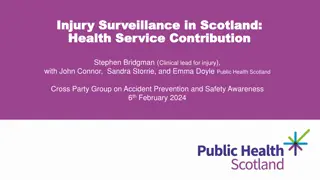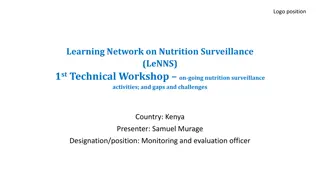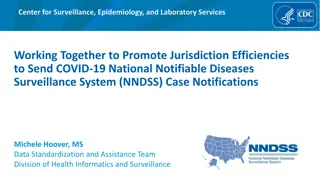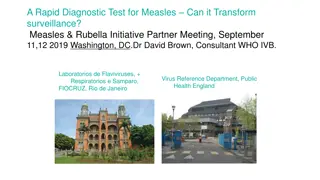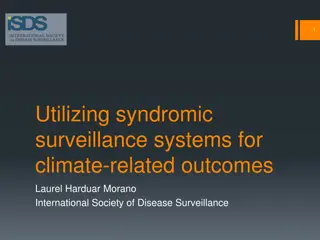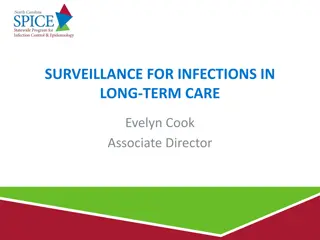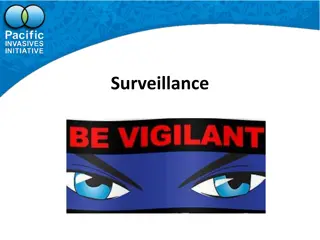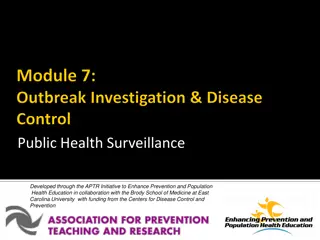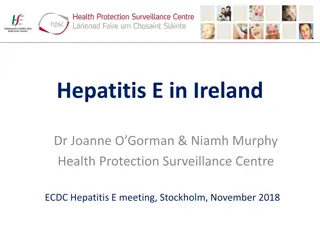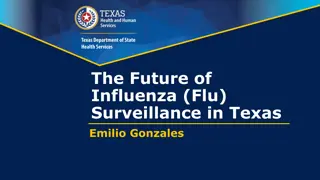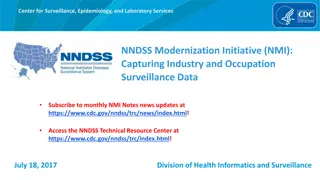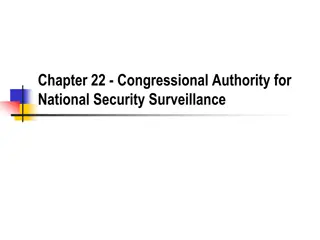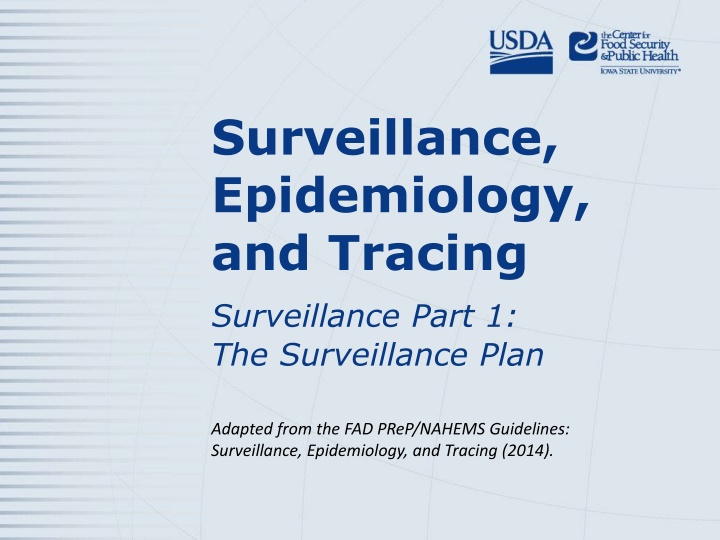
Surveillance Plans in Epidemiology
Explore the importance and components of surveillance plans in epidemiology as outlined in FAD PReP/NAHEMS Guidelines. Learn about the role of surveillance during disease outbreaks, the key elements of a surveillance plan, and its significance in identifying infectious agents and controlling outbreaks effectively.
Download Presentation

Please find below an Image/Link to download the presentation.
The content on the website is provided AS IS for your information and personal use only. It may not be sold, licensed, or shared on other websites without obtaining consent from the author. If you encounter any issues during the download, it is possible that the publisher has removed the file from their server.
You are allowed to download the files provided on this website for personal or commercial use, subject to the condition that they are used lawfully. All files are the property of their respective owners.
The content on the website is provided AS IS for your information and personal use only. It may not be sold, licensed, or shared on other websites without obtaining consent from the author.
E N D
Presentation Transcript
Surveillance, Epidemiology, and Tracing Surveillance Part 1: The Surveillance Plan Adapted from the FAD PReP/NAHEMS Guidelines: Surveillance, Epidemiology, and Tracing (2014).
This Presentation Defines surveillance Describes the development and components of a surveillance plan Identifies stakeholders and data sources FAD PReP/NAHEMS Guidelines: Surveillance, Epi, and Tracing - Surveillance Part 1 USDA APHIS and CFSPH
What is Surveillance? Surveillance Intensive form of data recording Gathering, documenting, and analyzing Surveillance systems Routine surveillance Assesses level of endemic disease in populations Looks for presence of FAD agents FAD PReP/NAHEMS Guidelines: Surveillance, Epi, and Tracing - Surveillance Part 1 USDA APHIS and CFSPH
Role of Surveillance During an FAD outbreak, surveillance plays a key role in: Identifying the infectious agent Determining the scope of the outbreak Assessing the effectiveness of eradication and control efforts Demonstrating a return to disease free status FAD PReP/NAHEMS Guidelines: Surveillance, Epi, and Tracing - Surveillance Part 1 USDA APHIS and CFSPH
The Surveillance Plan FAD PReP/NAHEMS Guidelines: Surveillance, Epi, and Tracing - Surveillance Part 1 USDA APHIS and CFSPH
Surveillance Plan Purpose, rationale, objectives Stakeholders Sampling considerations Population, methods, diagnostic testing Sampling techniques Plans for data analysis Implementation, budgeting, and evaluation plans FAD PReP/NAHEMS Guidelines: Surveillance, Epi, and Tracing - Surveillance Part 1 USDA APHIS and CFSPH
Surveillance Plan Elements Disease description Surveillance objectives Stakeholders and responsible parties Population description Case definitions Data sources Sampling methods Diagnostic tests FAD PReP/NAHEMS Guidelines: Surveillance, Epi, and Tracing - Surveillance Part 1 USDA APHIS and CFSPH
Disease Description Etiologic agent Geographic distribution Clinical signs Pathological findings Available laboratory tests Epidemiology Economic impact Methods of control FAD PReP/NAHEMS Guidelines: Surveillance, Epi, and Tracing - Surveillance Part 1 USDA APHIS and CFSPH
Surveillance Objectives Goals to be achieved through the use of the surveillance system FAD PReP/NAHEMS Guidelines: Surveillance, Epi, and Tracing - Surveillance Part 1 USDA APHIS and CFSPH
Stakeholders Stakeholders should be clearly identified May be included in surveillance planning and data collection activities May not specifically appear in the ICS Anyone participating in surveillance activities must receive training FAD PReP/NAHEMS Guidelines: Surveillance, Epi, and Tracing - Surveillance Part 1 USDA APHIS and CFSPH
Population Description Study population Subset of the target population Contains animals at risk of infection More than one may be identified FAD PReP/NAHEMS Guidelines: Surveillance, Epi, and Tracing - Surveillance Part 1 USDA APHIS and CFSPH
Case Definition Components General disease and pathogen information Etiologic agent Distribution Clinical signs Incubation period Differential diagnosis Transmission and reservoir Epidemiology Laboratory criteria Reporting criteria Control procedures Surveillance procedures FAD PReP/NAHEMS Guidelines: Surveillance, Epi, and Tracing - Surveillance Part 1 USDA APHIS and CFSPH
Case Definitions Suspect case Animal showing clinical signs compatible with FAD Presumptive positive case Animal with clinical signs consistent with FAD and positive test results Confirmed positive case Agent has been isolated and identified using approved tests FAD PReP/NAHEMS Guidelines: Surveillance, Epi, and Tracing - Surveillance Part 1 USDA APHIS and CFSPH
Data Sources FAD PReP/NAHEMS Guidelines: Surveillance, Epi, and Tracing - Surveillance Part 1 USDA APHIS and CFSPH
Livestock Producers May be the first to notice sick animals Maintain livestock records and production data Type, format and quality of farm data may vary from farm to farm Confidentiality issues FAD PReP/NAHEMS Guidelines: Surveillance, Epi, and Tracing - Surveillance Part 1 USDA APHIS and CFSPH
Veterinarians Often have early contact with sick animals Routine veterinary activities Calls to examine ill animals Medical records may be available Confidential documents Type, format, quality of information may vary FAD PReP/NAHEMS Guidelines: Surveillance, Epi, and Tracing - Surveillance Part 1 USDA APHIS and CFSPH
Livestock Organizations May be a source of data Number and distribution of animals owned by members May also help disseminate FAD information from a response effort FAD PReP/NAHEMS Guidelines: Surveillance, Epi, and Tracing - Surveillance Part 1 USDA APHIS and CFSPH
Slaughter Plants All animals undergo ante mortem and post mortem inspection Results recorded only for animals requiring disposition by FSIS Amount of information recorded varies May provide information in an FAD outbreak FAD PReP/NAHEMS Guidelines: Surveillance, Epi, and Tracing - Surveillance Part 1 USDA APHIS and CFSPH
Wildlife Data Potential data sources for wildlife Ground surveys Local reports Live animal capture May be difficult Consider wildlife density, movement patterns, and behavior FAD PReP/NAHEMS Guidelines: Surveillance, Epi, and Tracing - Surveillance Part 1 USDA APHIS and CFSPH
Sentinel Surveillance May be used to periodically assess the health status of a population Involves repeated sampling of a representative group of high risk animals Considerations Herd/site selection and animal type Frequency of sampling Testing protocol FAD PReP/NAHEMS Guidelines: Surveillance, Epi, and Tracing - Surveillance Part 1 USDA APHIS and CFSPH
Other Data Sources Auction/market records Disease reporting systems Disease control programs Targeted testing/screening Post mortem diagnostic specimen collection FAD PReP/NAHEMS Guidelines: Surveillance, Epi, and Tracing - Surveillance Part 1 USDA APHIS and CFSPH
For More Information FAD PReP/NAHEMS Guidelines: Surveillance, Epidemiology, and Tracing, and SOP: Surveillance http://www.aphis.usda.gov/fadprep Surveillance, Epidemiology, and Tracing web-based training module http://naherc.sws.iastate.edu/ FAD PReP/NAHEMS Guidelines: Surveillance, Epi, and Tracing - Surveillance Part 1 USDA APHIS and CFSPH
Guidelines Content Authors (CFSPH) Kerry Leedom Larson, DVM, MPH, PhD, DACVPM Glenda Dvorak, DVM, MPH, DACVPM Janice Mogan, DVM Courtney Blake, BA Reviewers (USDA APHIS VS) Dr. R. Alex Thompson Dr. Lowell Anderson Dr. Steve Goff Dr. Fred Bourgeois FAD PReP/NAHEMS Guidelines: Surveillance, Epi, and Tracing - Surveillance Part 1 USDA APHIS and CFSPH
Acknowledgments Development of this presentation was by the Center for Food Security and Public Health at Iowa State University through funding from the USDA APHIS Veterinary Services PPT Authors: Patricia Futoma, Veterinary Student; Kerry Leedom Larson, DVM, MPH, PhD, DACVPM Reviewers: Janice Mogan, DVM; Melissa Lang, BS


